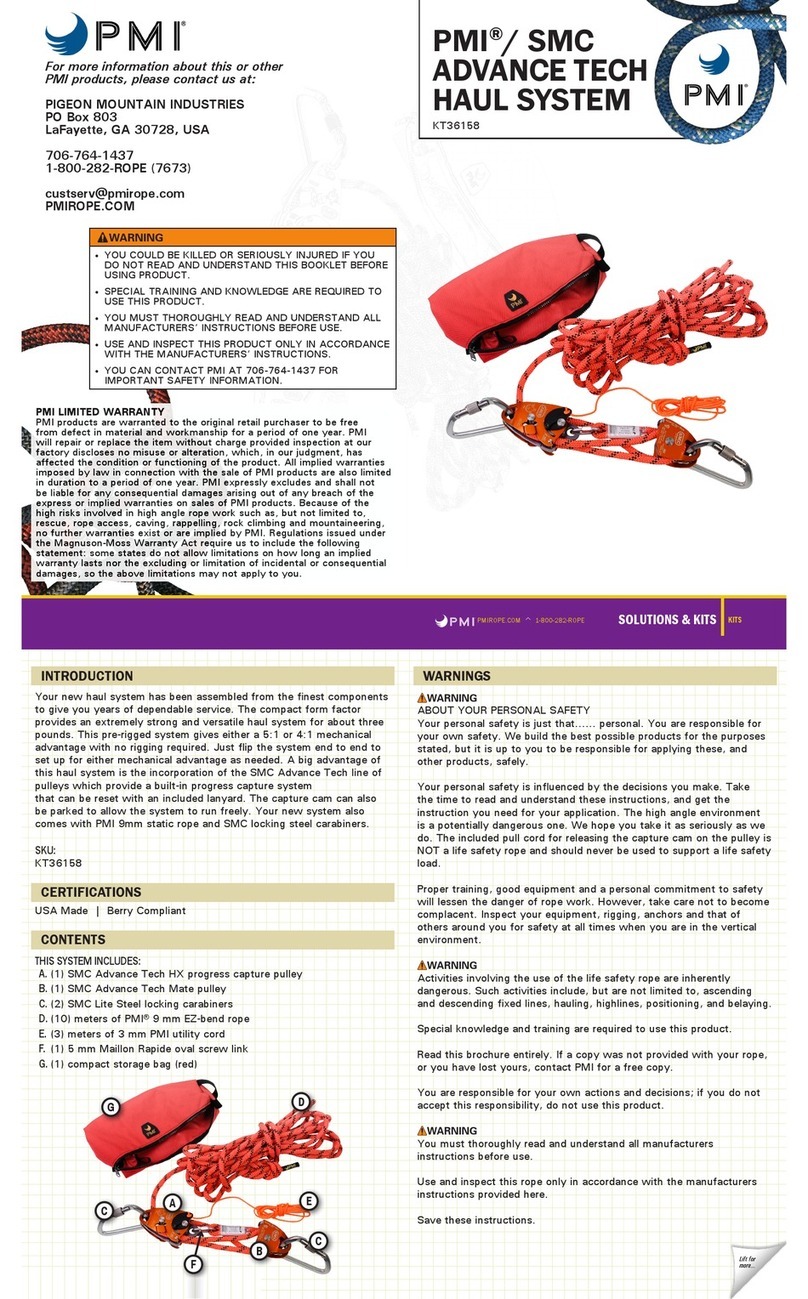
2
YOU COULD BE KILLED OR SERIOUSLY INJURED IF YOU DO NOT
READ AND UNDERSTAND THIS BOOKLET BEFORE USING THIS
PRODUCT.
SPECIAL TRAINING AND KNOWLEDGE ARE REQUIRED TO USE THIS
PRODUCT.
YOU MUST THOROUGHLY READ, UNDERSTAND AND REFER TO ALL
MANUFACTURER’S INSTRUCTIONS BEFORE AND AFTER EACH USE OF THIS
PRODUCT.
BEFORE USING THESE ROPES THE USER IS RESPONSIBLE TO DETERMINE
WHETHER THESE ROPES ARE SUITABLE FOR THE INTENDED USE AND THEIR
COMPATIBILITY WITH ALL HARDWARE TO BE USED.
USE AND INSPECTION OF THIS PRODUCT SHOULD ONLY BE DONE IN
ACCORDANCE WITH THE MANUFACTURER’S INSTRUCTIONS. INSPECTIONS
SHOULD ONLY BE CONDUCTED BY AN INDIVIDUAL DESIGNATED BY THE
EMPLOYER AS BEING COMPETENT FOR ALL TASKS REQUIRED.
DO NOT MAKE ANY ALTERATIONS TO THIS PRODUCT. ALTERATIONS TO
ANY PMI ROPES IMMEDIATELY VOID THE WARRANTY WITH THE EXCEPTION
OF CUTTING ROPE LENGTHS FROM SPOOLS OR ADDING ID/LABELING
INFORMATION.
MANUFACTURER’S INSTRUCTIONS SHALL BE PROVIDED TO USERS.
ROPES SHOULD NOT BE USED NEAR MOVING MACHINERY, ELECTRICAL
HAZARDS, SHARP EDGES, OR ABRASIVE SURFACES WITHOUT PROPER
ADDITIONAL SAFETY EQUIPMENT IN PLACE. IN ADDITION, ROPES SHOULD
BE PROTECTED DURING STORAGE, TRANSPORT AND USE, AS THEY CAN
MELT OR BURN AND FAIL IF EXPOSED TO FLAME OR HIGH TEMPERATURE.
PROTECT YOUR ROPE FROM ANYTHING THAT MIGHT DAMAGE IT, SUCH AS
ABRASION, ABRASIVE SURFACES, HEAT, AND CHEMICALS. A PROTECTIVE
ROLLER, PADDING, OR OTHER ITEM SHOULD BE PLACED BETWEEN THE ROPE
AND ANY SHARP EDGE.
PMI IS NOT RESPONSIBLE OR LIABLE IN ANY WAY FOR DAMAGES OF ANY
KIND, INJURY OR DEATH RESULTING FROM DIRECT OR INDIRECT INCIDENTS
RELATED TO THE USE OF ITS PRODUCTS.
IF YOU HAVE PURCHASED A ROPE WITH FACTORY TERMINATIONS, REFER
TO THE SECTION IN THESE INSTRUCTIONS TITLED “PMI TERMINATIONS”.
PLEASE CONTACT PMI AT 706-764-1437 TO ANSWER ANY ADDITIONAL
QUESTIONS REGARDING SAFETY INFORMATION AND THE USE OF THIS
PRODUCT.
ABOUT YOUR PERSONAL SAFETY
YOUR PERSONAL SAFETY IS JUST THAT...PERSONAL. YOU ARE
RESPONSIBLE FOR YOUR OWN SAFETY. WE BUILD THE BEST POSSIBLE
PRODUCTS FOR THE PURPOSES STATED, BUT IT IS UP TO YOU TO BE
RESPONSIBLE FOR USING THESE, AND OTHER PRODUCTS, SAFELY.
YOUR PERSONAL SAFETY IS INFLUENCED BY THE DECISIONS YOU MAKE.
TAKE THE TIME TO READ AND UNDERSTAND THESE INSTRUCTIONS, AND
GET THE TRAINING YOU NEED FOR YOUR APPLICATION. THE HIGH ANGLE
ENVIRONMENT IS A POTENTIALLY DANGEROUS ONE. WE HOPE YOU TAKE IT
AS SERIOUSLY AS WE DO.
WARNINGS




























